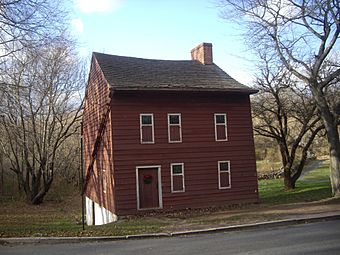Voorlezer's House facts for kids
|
Voorlezer's House
|
|
 |
|
| Location | Richmondtown, Staten Island, NY |
|---|---|
| Built | 1760s |
| Architectural style | Dutch-influenced vernacular |
| NRHP reference No. | 66000565 |
Quick facts for kids Significant dates |
|
| Added to NRHP | October 15, 1966 |
| Designated NHL | November 5, 1961 |
The Voorlezer's House is a historic wooden house in Historic Richmond Town on Staten Island, New York. It was once thought to be the oldest schoolhouse in the United States. For over 100 years, it was a private home. Today, the Staten Island Historical Society owns and manages it.
People used to think the house was built before 1696. It sits on land that was first claimed in 1680. However, it was more likely built in the 1760s. Jacob Rezeau probably built it. His family got the land in 1705.
By 1936, the building was in poor condition and almost torn down. The museum bought it in 1939. It was then fixed up to look like it did around 1700. The house first opened to the public on April 14, 1942. After another restoration, it reopened on June 27, 1985. It became a National Historic Landmark in 1961. It was added to the National Register of Historic Places when that list was created in 1966.
Contents
What Does "Voorlezer" Mean?
"Voorlezer" is a Dutch word. It means "fore-reader" or "one who reads to others." In early Dutch settlements in North America, a Voorlezer was a very important person. They had duties in local law, education, and religion. This title was common from the mid-1600s to the late 1700s.
A Voorlezer could help a pastor. If there was no pastor, they could lead church services and read from the Bible. They could also run a school.
House Design and Features
The house roof has an uneven slope. The front of the house is about 2 feet (0.6 meters) taller than the back. The foundation walls are 2 feet (0.6 meters) thick. They are made of rough field stones held together with mud and mortar. All the wood timbers are oak or white wood. They were cut from nearby forests and shaped with a broadaxe. A large stone and brick chimney is at one end of the house. Around 1800, the current staircases replaced the original ladder-like stairs. The house shows a Dutch style of building.
The first floor has a small living room. It also has a large room that was used for church services. The second floor has a small bedchamber. There is also a large room that people believe was the schoolroom. Extra floor beams in this room suggest it was made to hold many people. The floors are made of white pine boards. These boards are 14 to 16 inches (36 to 41 cm) wide. The windows and doors have been replaced. But the new ones match the low and wide look of the originals.
History of the Voorlezer's House
Early Land Ownership
In 1680, Robert Rider received a large piece of land. English Governor Sir Edmund Andros gave him 320 acres of land and 37 acres of salt meadow. In 1697, the Dutch Reformed Congregation bought a small part of this land. They bought about 271 square feet from James Hance Dye and James Fitchett. They planned to build the house there.
Use by the Dutch Church
The Voorlezer's House was never officially a church. But a building near it, possibly the first schoolhouse, was used by the Dutch Reformed Congregation. They met there until a French Church was built in 1698. Later, in 1718, a permanent Dutch Reformed Church was built on the north side of Staten Island.
Even though the congregation only stayed in Richmond for a short time, the Voorlezer's House was important. It was one of the first buildings in the village. Its presence helped Richmond become a key center for Staten Island. A few years later, the county government was set up there. Also, St. Andrew's Church for an English congregation was built from 1709 to 1712.
The House as a School
It is not fully clear if the current building was ever a school. Voorlezer Hendrick Kroesen lived on the site from 1696 to 1701. The building he lived in during that time was likely destroyed in the early 1700s. Children who went to the Voorlezer's house for school were probably 7 to 12 years old. Both boys and girls attended. Parents likely paid for schooling based on the subjects taught. Lessons were probably in Dutch.
Subjects taught most likely included:
- Reading: Students might have used hornbooks. Many textbooks from Amsterdam were also available. One example was "Stairway of Youth," which had 12 lessons.
- Writing: Not all students may have learned this skill.
- Arithmetic: This was an important skill for both boys and girls. It helped them manage household and business money as adults.
- Religion: Students were expected to learn the 129 questions and answers of the Heidelberg Catechism. This was used from 1563 until the 1800s.
- Dutch history: This new subject taught students about the Dutch Independence War from Spain.
Restoring the Building
In 1981, the house was closed for a big renovation. The goal was to make the building stable. They also wanted to keep as much of its original parts as possible. The kitchen was restored. New leaded windows were put in. These windows made the house look more like it did around 1696.
See Also




